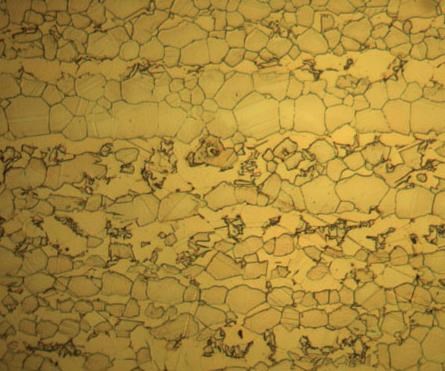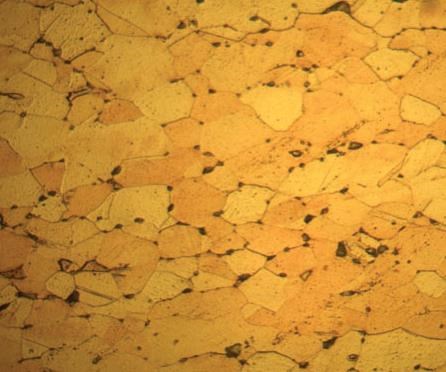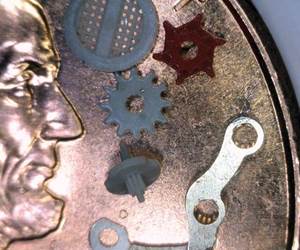Adjusting to Unleaded
A move is afoot to get lead out of plumbing pipes and fixtures that carry potable water. It's the law in California and could be to your state.
As professional machinists, we pride ourselves in our ability to make quality parts regardless of the material designated. But moving from leaded materials to unleaded materials can provide a challenge to an unprepared machinist. The shop that quotes a high volume job out of an unleaded product could find itself bleeding cash as it also finds itself out of capacity (because of longer times needed to make the parts), short of parts (because of quality issues and longer cycle times), and less productive (because of difficulties establishing a stable process and dealing with many tool adjustment shutdowns).
These issues mean lower profits for the enterprise and higher degrees of frustration in the shop. Do you have a process for moving from leaded to unleaded materials in your operations that will help you avoid this organizational pain and lost profits?
The Role of Lead
It is widely established that lead promotes machinability. To get the maximum production from automatic machines, additions of lead have been commonly used in metals, particularly steels and brasses.
The addition of lead to steel, while it is still liquid, results in the lead being deposited as pure metallic lead particles on the heads and tails of the manganese sulfides in steel. In brasses, the lead is dispersed in the grain boundaries. Pure lead is softer than steel, copper and zinc and has a coefficient of friction comparable to that of graphite lube.
Because of its role as an internal lubricant, it reduces friction, and thus heat. Lead allows the metals to which it has been added to be machined at much higher speeds than the comparable non-leaded grades. These higher speeds [rpm or surface feet per minute (sfm)] result in shorter cycle times to produce each part.
These faster cycle times make lead a positive factor for reducing the cost of machining the part out of barstock and reducing the energy consumption of machining. This is the reason that the European Union has exempted lead in certain alloys for machining in its End of Life Vehicles (ELV) and Reduction of Hazardous Substances (RoHS) regulations. (ELV Exemption Statement: Lead as an alloying element: 1. Steel for machining purposes…as much as 0.35 percent by weight; copper alloy containing as much as 4 percent lead by weight. RoHS Exemption Statement: Annex: Applications of lead…which are exempted from the requirements of Article 4(1) Line 6: “Lead as an alloying element in steel containing as much as 0.35 percent lead by weight…and as a copper alloy containing as much as 4 percent by weight.)
Get the Lead Out
Nevertheless, there are some applications for which any lead content in the material is now, or could in the future, become problematic. Potable water fixtures, faucets and taps for domestic water are one such area for brass. California legislation (AB 1953) is the current driver to reduce lead in the brass materials machined in shops.
On September 30, 2006, Governor Arnold Schwarzenegger signed California Assembly Bill 1953 (AB 1953) into law. This new law defined “lead free” to mean “not more than a weighted average of 0.25 percent lead content in pipe and fittings.” It covers “all devices at the point-of-use that are intended to dispense water for human consumption.” (Note, this does not treat residential or nonresidential fixtures differently.)
According to AB 1953, “No person shall introduce into commerce, for use in California, any pipe, pipe or plumbing fitting, or fixture intended to convey or dispense water for human consumption through drinking water or cooking that is not lead free. This includes kitchen faucets, bathroom faucets and any other end-use devices intended to convey or dispense water for human consumption through drinking or cooking.” This law goes into effect January 1, 2010.
For a shop considering options for the replacement of 360 brass—without question one of the easiest materials to machine—for parts that will be going into potable water applications, here is what today’s 360 brass (UNS C36000) has allowed shops to ignore because of its ease of machining:
Surface finish. Surface finish has been a breeze using 360 brass. It’s a short chip material and requires next to no fussing over chip control and chip breaking. After all, it contains lead lubricant inside the material to help with the chip breaking and lubrication. Tooling design has been a non-issue for most of us on this best cutting material.
Machine rigidity. It’s 360 brass and easy to cut. The assumption that manufacturers will always be cutting this “easy stuff” has allowed many to let the adjustment of gibs and slides and machine maintenance fall to a lower priority. It’s not like using a lot of horsepower on this grade when the chips literally fly off the tool at the highest rpms.
Thermal issues—not! 360 brass has built-in lead lubricant and thermal conductivity that we are used to. Not all of the unleaded alternative grades have similar conductivity. Therefore, controlling the heat has been routine for us, but could be an issue with the unleaded replacements.
Cycle times—fast! At 300 sfm just for starters, low cycle times for part production are expected. Time is money. So what happens when we quote using a material that needs more force to shear the chip; more thermal control to remove the heat; better tooling to take the forces and abrasion and make this new, long, difficult-to-break chip go where it is supposed to go?
Brass Alternatives
There are several alternative brass grades that can be used to meet the requirements of AB 1953 when the engineers calculate the “weighted average” lead content of the parts in contact with the water.
C69300 Green Dot Eco Brass from Chase Brass Co. contains no lead at all. This makes compliance with the California rule AB 1953 a non-issue. Because this material uses another mechanism for attaining better machinability, a different set of issues for the shop floor arise when compared with our leaded standby, 360 brass. These issues include higher strength (hardness) and increased tool wear. This proprietary grade is stronger than stainless steel and relies on a system of copper-zinc-silicate intermetallic compounds to provide the chip breakage. This combination results in more tool wear than with 360. Smooth surfaces and an 80-percent machinability rating for this no-lead C69300 material make it a logical choice for potable water applications, once the shop learns the nuances of machining this grade.
Machining C69300: Decreasing cycle time is the goal. With no lead as an internal lubricant and a different (lower) thermal conductivity than 360, the approach to machining must adjust to issues of heat control, reduced surface footage (lower rpms) and higher tool wear. Here are some things to consider:
• Increase the feed. We’re losing speed because we
lost the lead as lubricant. If we keep the same speeds, we’ll really have problems. While it’s necessary to decrease the sfm for heat control purposes, the feed rate can be increased to maintain relatively constant cubic inches of removal per minute rate. A good place to start would be 0.006 inch per revolution to get cycle times in the ballpark of the prior 360 brass benchmark.
• Improve the tool. Anybody can make parts using 360 brass and jobber quality tools. 360 brass has 4 percent lead; users give up the lead for environmental benefits and will pay for that with loss of machining benefits. Putting money into better grades of tool materials, especially for interrupted cuts on hexes, will be money well spent. Because of the thermal differences, for this material, more positive clearance and rake angles should be ensured. When using carbide, AlTiN and TiN coatings have been reported to keep the tools productive longer.
• Pay attention to heat. The loss of lead’s lubricity and the different thermal conductivity of this material mean that adjustments for drilling compared with 360 brass are in order. Consider drills with higher helix angle, increased clearance angles and wider flutes. While carbide insert drills and through-tool coolant are not “standard procedure” for brass, these strategies may pay off with this material.
C27450: Alloy 2745 from Mueller Brass is a modification of the UNS C36000 chemistry in that the missing lead is replaced with zinc. This grade is not proprietary; it is covered by industry consensus standards. It keeps a small amount of lead—about 0.25 weight percent maximum—which means that parts made from it meet the AB 1953 definition of lead free. While this grade has approximately the same tensile strength as 360 brass, because it doesn’t have any internal chip breaking constituents, it requires more horsepower to get the chip deformed to the point that it will break. This grade produces a Type III chip, which means issues with birds’ nests and the need to pay much closer attention on drilled parts.
Machining Alloy 2745: The first reports of machining
this grade were strikingly familiar. The machinist’s experience followed closely the experience of shops moving from 12L14 to grade 1215 steel in the late 1990s. Loss of lead in 1215 meant loss of speed, loss of speed meant loss of cycle time, and loss of lead and speed meant tools and machine issues needed to be addressed. It seems to be the same thing this time around in brass.
1. First things first. Manufacturers should ask themselves what condition their machines are in. This material requires far more rigidity than the easy-cutting 360 brass—more horsepower in order to get the chip to shear. It is important to ensure that a machine is tight, well adjusted and has the power to do the job.
2. Manage the chip. Everything about tooling is even more critical when the chip is Type III, long and continuous. Standard tooling should not be used. Chip control is the name of the game here. On all but the most aggressive interrupted cuts, carbide should be considered. Where there’s more heat, there’s usually a call for coated carbide. Coatings can be helpful because without lead, heat is always an issue. Abe Lincoln said if he had 8 hours to chop down a tree, he’d spend 7 hours sharpening his axe. The same amount of thinking should not go into tool design for chip control with this material, especially for critical surface finish applications. Positive rake and aggressive chipbreakers (on cams as well as tools) should be considered.
3. Slow it down and increase the feed. And deliver the proper metalworking fluid to where the work is being performed. That probably means using through-tool coolant for drills, even though the workpiece is yellow in color. It will help with the heat, the lubricity and the tool life and will help move the chips out of the hole. Since the lead was lost, the speed should be reduced and the feed should be increased to get to a similar removal volume. If a shop is running HSS and getting a lot of tool failures, it’s a safe bet that the failures are heat related.
Not Hard to Run, Just Different
Most shops have run parts out of 12L14 and then some out of 1215. Both grades run, make chips and make good parts. They’ll run on a well-maintained, solid machine. Chips will be produced from them and the parts will meet the print. However, the process will be different than with the “other yellow bar” with lead that many shops are used to using.
Several different approaches can be used: increased feed rather than trying to reduce cycle time with high speed; improved tools and coatings rather than the cheapest that will get the parts “out;” differently designed tools to handle the chips and the heat. Increased rake angles and clearances should prevent the heat related failures from plaguing shops. It’s the same with through-drill coolant.
If only leaded brass has been used in a shop, and these unleaded materials are approached the same way, there will be a steep learning curve. But if a shop realizes that these yellow bars have the strength of stainless steel and behave more like 1215 steel than brass, the shop will succeed in running these profitably.
Related Content
SW HMC Functions as Independent Manufacturing Cell
PMTS 2023: SW North America’s BA 322i is a horizontal machining center created to function as an independent manufacturing cell that can store enough workpieces for an entire shift.
Read MoreUnderstanding Micro-Milling Machine Technology
Micro-milling can be a companion process to turning-based production machining. This article looks at some of the technologies that go into a micro-milling machine and why they are important to successful operation.
Read MoreVideo Tech Brief: Five-Axis Machining’s Value for the Medical Industry
Watch to see how a medical bone plate is created on a five-axis machining center.
Read MoreCompact VMC Built for Diverse, Simultaneous Applications
The compact model is well suited for shops that want an integrated 5-axis solution for virtually any part that has previously required multiple operations or setups.
Read MoreRead Next
A Tooling Workshop Worth a Visit
Marubeni Citizen-Cincom’s tooling and accessory workshop offers a chance to learn more about ancillary devices that can boost machining efficiency and capability.
Read MoreDo You Have Single Points of Failure?
Plans need to be in place before a catastrophic event occurs.
Read More5 Aspects of PMTS I Appreciate
The three-day edition of the 2025 Precision Machining Technology Show kicks off at the start of April. I’ll be there, and here are some reasons why.
Read More
























